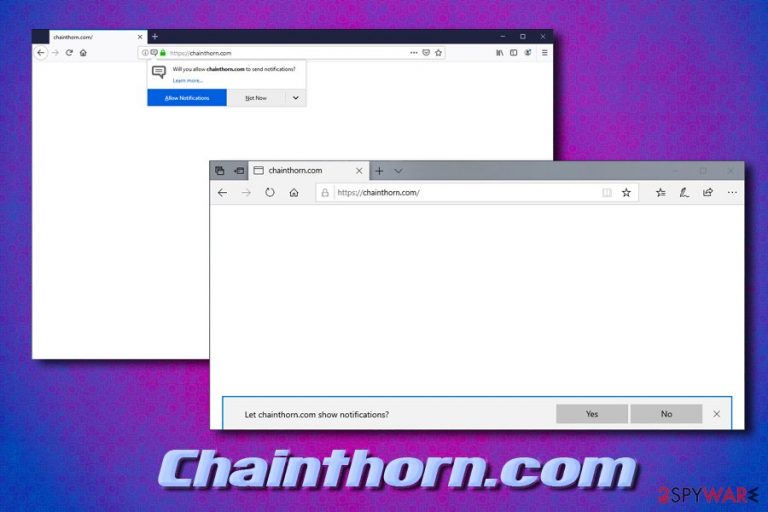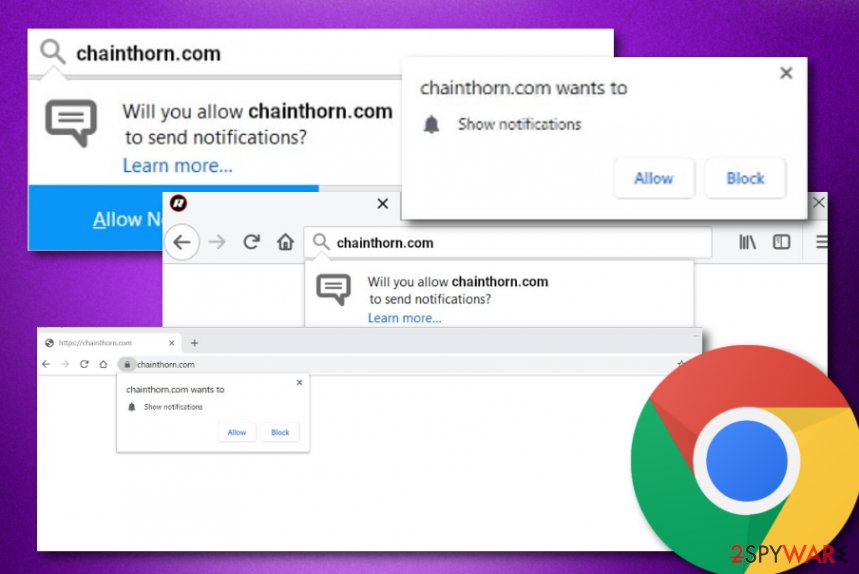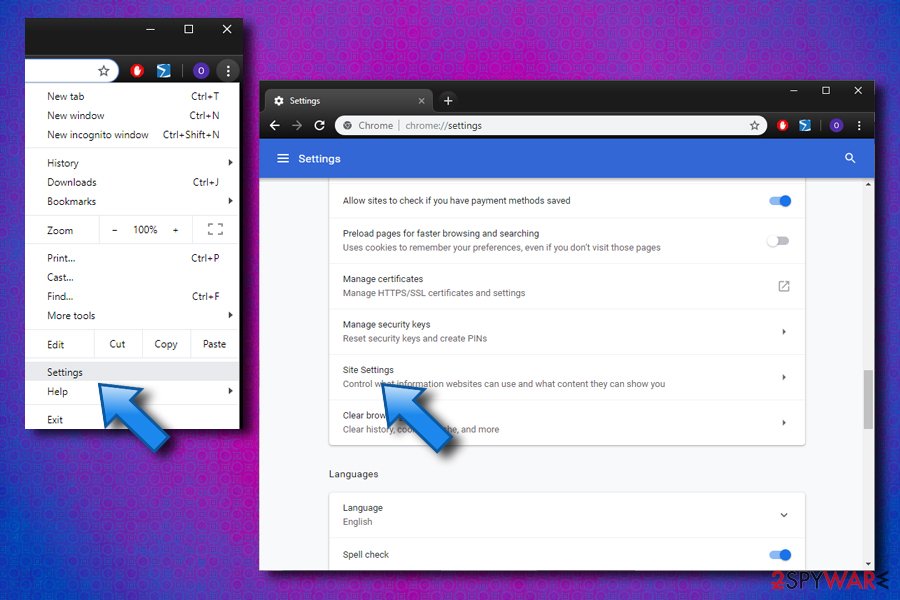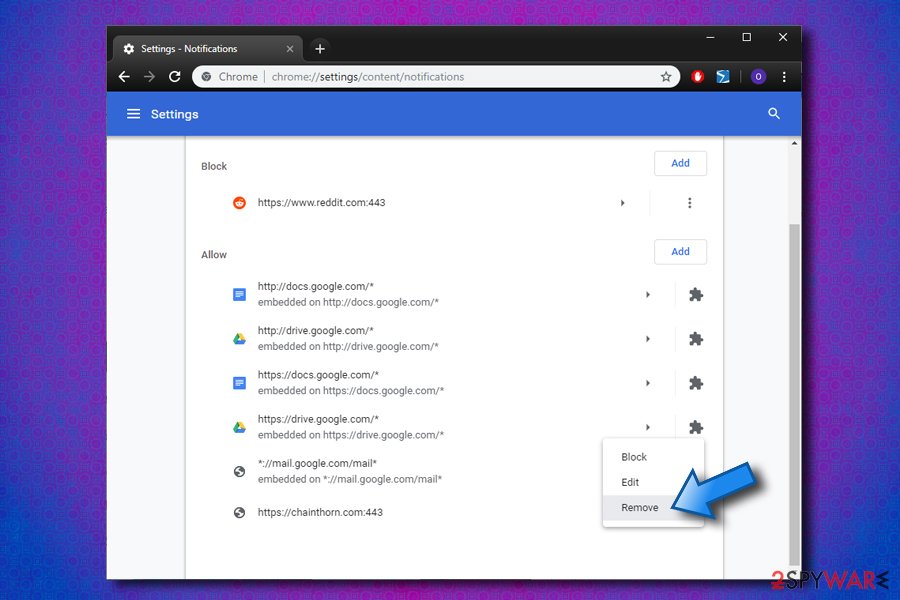Chainthorn.com (Removal Instructions) - updated Dec 2019
Chainthorn.com Removal Guide
What is Chainthorn.com?
Chainthorn is a suspicious website that tries to push notifications directly to users' desktops

Chainthorn.com is a push notification virus that is closely associated with adware,[1] although users might encounter the site when redirected from somewhere else. Just as many other sites of such kind, it asks users to allow notifications to be shown to view the alleged content which, in fact, does not even exist. The adware has also earned the name of Chainthorn virus due to the secrecy that its activities are based on. Besides, extensions related to this adware have been mostly spotted on Google Chrome web browsers, according to users' reports.[2]
As soon as users agree to Chainthorn.com request, they will start receiving deceptive pop-ups, deals, banners, offers, flashing windows and other intrusive content on Google Chrome, Safari, Mozilla Firefox, or any different installed browser. What is more, the activities may continue after the browser is turned off, and notifications will be delivered directly to desktops.
| Name | Chainthorn.com |
| Type | Push notification virus |
| Category | Adware/PUP |
| Infiltration | Software bundling, third-party sites |
| Main dangers | Installation of other potentially unwanted software, money loss, malware infection |
| Termination | Use security software or our manual removal guide below |
| Recovery | To make sure your system is running well after the infection, scan it with FortectIntego |
Without a doubt, the best way to remove Chainthorn notifications and pop-ups is not to enable them in the first place, although web browser setting tweak can fix the issue (we explain how to do that below – check the bottom section of the article). Nevertheless, if an adware program is involved, you will have to delete the potentially unwanted application from your device to stop redirects to scam, phishing, and other malicious sites similar to Chainthorn.com.
By itself, adware is not considered to be malicious like malware, although the increasing security and privacy concerns from industry experts are rising. Therefore, adware infections like Chainthorn.com should never be underestimated, as careless web browsing on Google Chrome, Safari, Mozilla Firefox, Internet Explorer or another browser might lead you to phishing, scam or even malware-laden websites.
While intrusive pop-ups and other sponsored content should be big enough reason to start Chainthorn removal, another alarming feature of adware is information tracking. In most of the cases, the PUP places tracking cookies, web beacons,[3] and other tracking technologies on your browser, which can track the following information:
- IP address
- Search queries
- Goelocation
- ISP
- Cookies
- Technical details
- Sites visited and the visit duration;
- Links clicked, etc.
Even though this information is mostly considered to be anonymous, (nevertheless, in some countries or the US states, IP address is considered to be private data), you should not allow unknown parties affiliated with Chainthorn.com developers tracking you. Not only will alter the way you browse the internet, but it might also offer you goods or services, not of good quality.

Continuously, some adware programs, possibly Chainthorn.com also, might collect not only browsing-related data but track some private details such as the name/surname, residence address, billing address, or email of the user. Such information is not the one you would want to reveal to scammers or third-party developers as it might be misused for illegitimate purposes in the future.
Thus, you can negate all the adverse effects by removing the potentially unwanted program that is associated with Chainthorn.com developers. You can either scan your PC with anti-virus software or delete the unwanted program manually by resetting all the installed browsers. After that, experts[4] recommend scanning the device with FortectIntego to fix virus damage.
Also, note that Chainthorn.com might be capable of modifying web browser applications via the homepage and new tab sections. These changes can be reversed by terminating the potentially unwanted program only. This also includes cleaning infected web browser applications from bogus extensions, add-ons, and plug-ins. If you do not eliminate such components, the adware might return easily.
Continuously, potentially unwanted applications such as Chainthorn.com virus might be capable of eating your system's resources such as the CPU and GPU power. This sometimes is necessary in order to let the program push an excessive amount of adverts. If this happens, you might find your system and software starting to struggling. Afterward, it will supposedly prevent you from carrying out quality-full work.

PUPs are not always a minor threat – avoid installing them in the first place
Browser redirect viruses might be pretty harmless, while, in other cases, might render the computer vulnerable to cyber attacks, especially if users start clicking on suspicious ads and sponsored content. Therefore, it is best to avoid potentially unwanted programs to bypass unnecessary risks.
The prevalence of PUPs can be explained by its deceptive distribution method – software bundling. In most of cases, users are quite hasty when it comes to the installation of freeware or shareware. However, free applications from third-party sites often include additional components that are often shady – adware, browser hijackers, or even malware like cryptominers.
Thus, when installing new software, pay close attention to the installation instructions, and never rush through steps. Additionally, always make sure you opt for Advanced/Custom settings instead of Recommended/Quick ones, as that's where most of the optional programs are hidden. Simply untick all the pre-selected boxes before proceeding, and you will avoid the installation of PUPs.
Remove Chainthorn.com notifications by uninstalling adware applications from your computer
As we previously mentioned, the appearance of the Chainthorn.com site on the web browser does not necessarily mean adware infection. However, if you noticed that Google Chrome or another browser is leading you to tech support scam, phishing, push notification sites on a regular basis, it is highly likely that adware is involved.
To remove Chainthorn.com virus from your device, you can scan it with anti-malware software or, if you are aware which program is causing troubles, uninstall via the Control Panel in Windows or moving it to Trash on Mac. After that, you can reset each of the installed browsers to make sure all elements and altered settings of the unwanted program are terminated.
If your device is not affected with adware, but you allowed notifications to be shown, you can achieve Chainthorn removal by following these steps:
Google Chrome
- Click Menu and select Settings
- Click Advanced and go to Privacy and security > Site Settings > Notifications

- You should see Chainthorn.com under Allow
- Pick More Actions and then click on Block and then Remove

Mozilla Firefox:
- Select Menu and then click Options
- Go to Privacy & Security > Notifications
- Select Settings find Chainthorn.com entry
- Pick Block from the drop-down menu
Safari:
- Click on Safari and then select Preferences
- Pick Notifications
- Locate Chainthorn.com and select Deny
MS Edge:
- Click on More and select Settings
- Now pick View advanced settings
- Find Chainthorn.com and turn off notifications from being shown
You may remove virus damage with a help of FortectIntego. SpyHunter 5Combo Cleaner and Malwarebytes are recommended to detect potentially unwanted programs and viruses with all their files and registry entries that are related to them.
Getting rid of Chainthorn.com. Follow these steps
Uninstall from Windows
To remove the intrusive activity of Chainthorn.com form Windows, you should do the following:
Instructions for Windows 10/8 machines:
- Enter Control Panel into Windows search box and hit Enter or click on the search result.
- Under Programs, select Uninstall a program.

- From the list, find the entry of the suspicious program.
- Right-click on the application and select Uninstall.
- If User Account Control shows up, click Yes.
- Wait till uninstallation process is complete and click OK.

If you are Windows 7/XP user, proceed with the following instructions:
- Click on Windows Start > Control Panel located on the right pane (if you are Windows XP user, click on Add/Remove Programs).
- In Control Panel, select Programs > Uninstall a program.

- Pick the unwanted application by clicking on it once.
- At the top, click Uninstall/Change.
- In the confirmation prompt, pick Yes.
- Click OK once the removal process is finished.
Delete from macOS
Macs are not immune to adware. If you are suffering from PUP infection, perform these steps:
Remove items from Applications folder:
- From the menu bar, select Go > Applications.
- In the Applications folder, look for all related entries.
- Click on the app and drag it to Trash (or right-click and pick Move to Trash)

To fully remove an unwanted app, you need to access Application Support, LaunchAgents, and LaunchDaemons folders and delete relevant files:
- Select Go > Go to Folder.
- Enter /Library/Application Support and click Go or press Enter.
- In the Application Support folder, look for any dubious entries and then delete them.
- Now enter /Library/LaunchAgents and /Library/LaunchDaemons folders the same way and terminate all the related .plist files.

Remove from Microsoft Edge
Delete unwanted extensions from MS Edge:
- Select Menu (three horizontal dots at the top-right of the browser window) and pick Extensions.
- From the list, pick the extension and click on the Gear icon.
- Click on Uninstall at the bottom.

Clear cookies and other browser data:
- Click on the Menu (three horizontal dots at the top-right of the browser window) and select Privacy & security.
- Under Clear browsing data, pick Choose what to clear.
- Select everything (apart from passwords, although you might want to include Media licenses as well, if applicable) and click on Clear.

Restore new tab and homepage settings:
- Click the menu icon and choose Settings.
- Then find On startup section.
- Click Disable if you found any suspicious domain.
Reset MS Edge if the above steps did not work:
- Press on Ctrl + Shift + Esc to open Task Manager.
- Click on More details arrow at the bottom of the window.
- Select Details tab.
- Now scroll down and locate every entry with Microsoft Edge name in it. Right-click on each of them and select End Task to stop MS Edge from running.

If this solution failed to help you, you need to use an advanced Edge reset method. Note that you need to backup your data before proceeding.
- Find the following folder on your computer: C:\\Users\\%username%\\AppData\\Local\\Packages\\Microsoft.MicrosoftEdge_8wekyb3d8bbwe.
- Press Ctrl + A on your keyboard to select all folders.
- Right-click on them and pick Delete

- Now right-click on the Start button and pick Windows PowerShell (Admin).
- When the new window opens, copy and paste the following command, and then press Enter:
Get-AppXPackage -AllUsers -Name Microsoft.MicrosoftEdge | Foreach {Add-AppxPackage -DisableDevelopmentMode -Register “$($_.InstallLocation)\\AppXManifest.xml” -Verbose

Instructions for Chromium-based Edge
Delete extensions from MS Edge (Chromium):
- Open Edge and click select Settings > Extensions.
- Delete unwanted extensions by clicking Remove.

Clear cache and site data:
- Click on Menu and go to Settings.
- Select Privacy, search and services.
- Under Clear browsing data, pick Choose what to clear.
- Under Time range, pick All time.
- Select Clear now.

Reset Chromium-based MS Edge:
- Click on Menu and select Settings.
- On the left side, pick Reset settings.
- Select Restore settings to their default values.
- Confirm with Reset.

Remove from Mozilla Firefox (FF)
You should fully reset Mozilla Firefox after PUP termination:
Remove dangerous extensions:
- Open Mozilla Firefox browser and click on the Menu (three horizontal lines at the top-right of the window).
- Select Add-ons.
- In here, select unwanted plugin and click Remove.

Reset the homepage:
- Click three horizontal lines at the top right corner to open the menu.
- Choose Options.
- Under Home options, enter your preferred site that will open every time you newly open the Mozilla Firefox.
Clear cookies and site data:
- Click Menu and pick Settings.
- Go to Privacy & Security section.
- Scroll down to locate Cookies and Site Data.
- Click on Clear Data…
- Select Cookies and Site Data, as well as Cached Web Content and press Clear.

Reset Mozilla Firefox
If clearing the browser as explained above did not help, reset Mozilla Firefox:
- Open Mozilla Firefox browser and click the Menu.
- Go to Help and then choose Troubleshooting Information.

- Under Give Firefox a tune up section, click on Refresh Firefox…
- Once the pop-up shows up, confirm the action by pressing on Refresh Firefox.

Remove from Google Chrome
Adware and other PUPs often leave web browser settings altered, even after its removal. Thus, make sure you reset Google Chrome as follows:
Delete malicious extensions from Google Chrome:
- Open Google Chrome, click on the Menu (three vertical dots at the top-right corner) and select More tools > Extensions.
- In the newly opened window, you will see all the installed extensions. Uninstall all the suspicious plugins that might be related to the unwanted program by clicking Remove.

Clear cache and web data from Chrome:
- Click on Menu and pick Settings.
- Under Privacy and security, select Clear browsing data.
- Select Browsing history, Cookies and other site data, as well as Cached images and files.
- Click Clear data.

Change your homepage:
- Click menu and choose Settings.
- Look for a suspicious site in the On startup section.
- Click on Open a specific or set of pages and click on three dots to find the Remove option.
Reset Google Chrome:
If the previous methods did not help you, reset Google Chrome to eliminate all the unwanted components:
- Click on Menu and select Settings.
- In the Settings, scroll down and click Advanced.
- Scroll down and locate Reset and clean up section.
- Now click Restore settings to their original defaults.
- Confirm with Reset settings.

Delete from Safari
Remove unwanted extensions from Safari:
- Click Safari > Preferences…
- In the new window, pick Extensions.
- Select the unwanted extension and select Uninstall.

Clear cookies and other website data from Safari:
- Click Safari > Clear History…
- From the drop-down menu under Clear, pick all history.
- Confirm with Clear History.

Reset Safari if the above-mentioned steps did not help you:
- Click Safari > Preferences…
- Go to Advanced tab.
- Tick the Show Develop menu in menu bar.
- From the menu bar, click Develop, and then select Empty Caches.

After uninstalling this potentially unwanted program (PUP) and fixing each of your web browsers, we recommend you to scan your PC system with a reputable anti-spyware. This will help you to get rid of Chainthorn.com registry traces and will also identify related parasites or possible malware infections on your computer. For that you can use our top-rated malware remover: FortectIntego, SpyHunter 5Combo Cleaner or Malwarebytes.
How to prevent from getting adware
Do not let government spy on you
The government has many issues in regards to tracking users' data and spying on citizens, so you should take this into consideration and learn more about shady information gathering practices. Avoid any unwanted government tracking or spying by going totally anonymous on the internet.
You can choose a different location when you go online and access any material you want without particular content restrictions. You can easily enjoy internet connection without any risks of being hacked by using Private Internet Access VPN.
Control the information that can be accessed by government any other unwanted party and surf online without being spied on. Even if you are not involved in illegal activities or trust your selection of services, platforms, be suspicious for your own security and take precautionary measures by using the VPN service.
Backup files for the later use, in case of the malware attack
Computer users can suffer from data losses due to cyber infections or their own faulty doings. Ransomware can encrypt and hold files hostage, while unforeseen power cuts might cause a loss of important documents. If you have proper up-to-date backups, you can easily recover after such an incident and get back to work. It is also equally important to update backups on a regular basis so that the newest information remains intact – you can set this process to be performed automatically.
When you have the previous version of every important document or project you can avoid frustration and breakdowns. It comes in handy when malware strikes out of nowhere. Use Data Recovery Pro for the data restoration process.
- ^ Adware. Techopedia. Where IT and Business Meet.
- ^ Chrome chainthorn.com policy - malware?. Reddit.com. Tech support.
- ^ Vangie Beal. Web beacon. Webopedia. Online Tech Dictionary for Students, Educators and IT Professionals.
- ^ Virusler. Virusler. Cybersecurity experts from Turkey.
